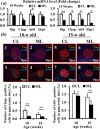Administration of mulberry leaves maintains pancreatic β-cell mass in obese/type 2 diabetes mellitus mouse model
- PMID: 32375753
- PMCID: PMC7201661
- DOI: 10.1186/s12906-020-02933-4
Administration of mulberry leaves maintains pancreatic β-cell mass in obese/type 2 diabetes mellitus mouse model
Abstract
Background: Type 2 diabetes mellitus is characterized by insulin resistance and pancreatic β-cell dysfunction. A decrease in β-cell mass, which occurs during the progression of Type 2 diabetes mellitus, contributes to impaired insulin secretion. Mulberry leaves contain various nutritional components that exert anti-diabetic and anti-atherogenic effects. The present study analyzed the effects of mulberry leaf intake on pancreatic β-cells to clarify the mechanisms underlying its anti-diabetic function.
Methods: Mulberry leaves (Morus alba L.) were dried at 180 °C for 8 s in a hot-air mill and fed to obesity/Type 2 diabetes mellitus db/db mouse models at 5% (w/w) as part of a normal diet from 7 to 10, 15, or 20 weeks of age. An intraperitoneal glucose tolerance test was then performed on the mice. To evaluate the β-cell mass, the pancreas was subjected to immunohistological analysis with an anti-insulin antibody. A TUNEL assay and immunohistological analysis with a proliferation marker was also performed. Expression levels of endoplasmic reticulum stress-responsible genes and proliferation markers were assessed by quantitative RT-PCR.
Results: Intake of mulberry leaves maintained the β-cell function of db/db mice. Moreover, oral administration of mulberry leaves significantly decreased cell death by reducing endoplasmic reticulum stress in the pancreas. Mulberry leaves significantly increased proliferation of β-cells and the expression of pancreatic duodenal homeobox1 mRNA in the pancreas.
Conclusion: Considered together, these results indicate that dietary mulberry leaf administration can maintain insulin levels and pancreatic β-cell mass, at least in part, by suppressing endoplasmic reticulum stress in Type 2 diabetes mellitus mouse models.
Keywords: Endoplasmic reticulum stress; Mulberry leaves; Obesity; Type 2 diabetes; β-Cell.
Conflict of interest statement
The authors declare that they have no completing of interest.
Figures






References
-
- World Health Organization . Global Report on Diabetes. World Health Organization. 2016. p. 88.
MeSH terms
Substances
Grants and funding
- Grants-in-Aid for Scientific Research (KAKENHI) 26460338, 17K08592/Japan Society for the Promotion of Science
- Grants-in-Aid for Scientific Research (KAKENHI) 15K08230/Japan Society for the Promotion of Science
- Core-to-Core program, B. Asia-Africa Science Platforms/Japan Society for the Promotion of Science
LinkOut - more resources
Full Text Sources
Medical
Miscellaneous

